Moto Guzzi V100 Mandello Review
Words by Kris Hodgson
Images Dean Walters, Videography Lee Turner
The V100 Mandello represents an enormous leap forward for Moto Guzzi, as a more powerful, technology laden high-spec machine, in some ways harkening back to the manufacturer’s heyday, when they were – at times – at the pinnacle of motorcycling development and racing. Of course the real question is how does the new machine ride, and deliver on that promise…
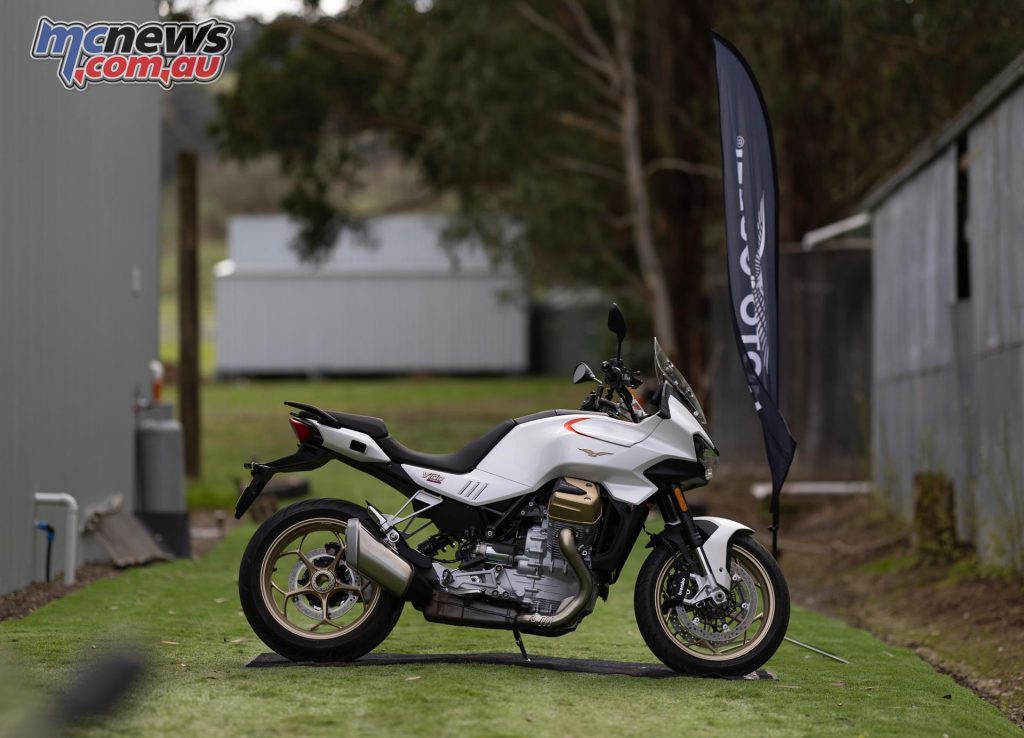
Moto Guzzi is synonymous with a quirky Italian character that’s really like nothing else. Their racing days are well over and the brand has in recent times been delivering more laid back machines.
The V85 TT was a big step forward for Guzzi and now the new V100 Mandello aims to step that up another notch. It is an all-new creation but has to tread a careful line, Guzzi fanatics are a unique group and no doubt important, but equally this new sports-tourer is designed to capture much wider appeal.
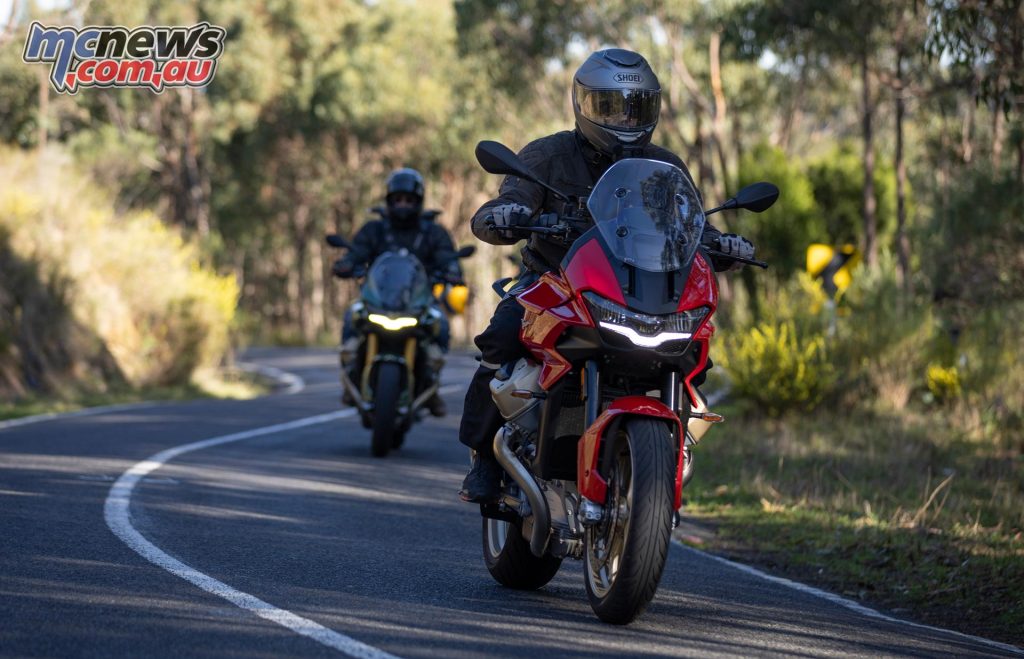
Motorcycles have never been better, but it’s probably fair to say that in some ways that’s come at the cost of individuality and modern tech seems to be further flattening that curve. That won’t matter to everyone, but I do think it still matters to enough riders to count for something, while also allowing the more unique motorcycles to really stand out.
Enter the V100 Mandello.
So how did Moto Guzzi handle balancing the demands of tradition, alongside delivering a world class sports tourer?
By my reckoning, exceptionally well.
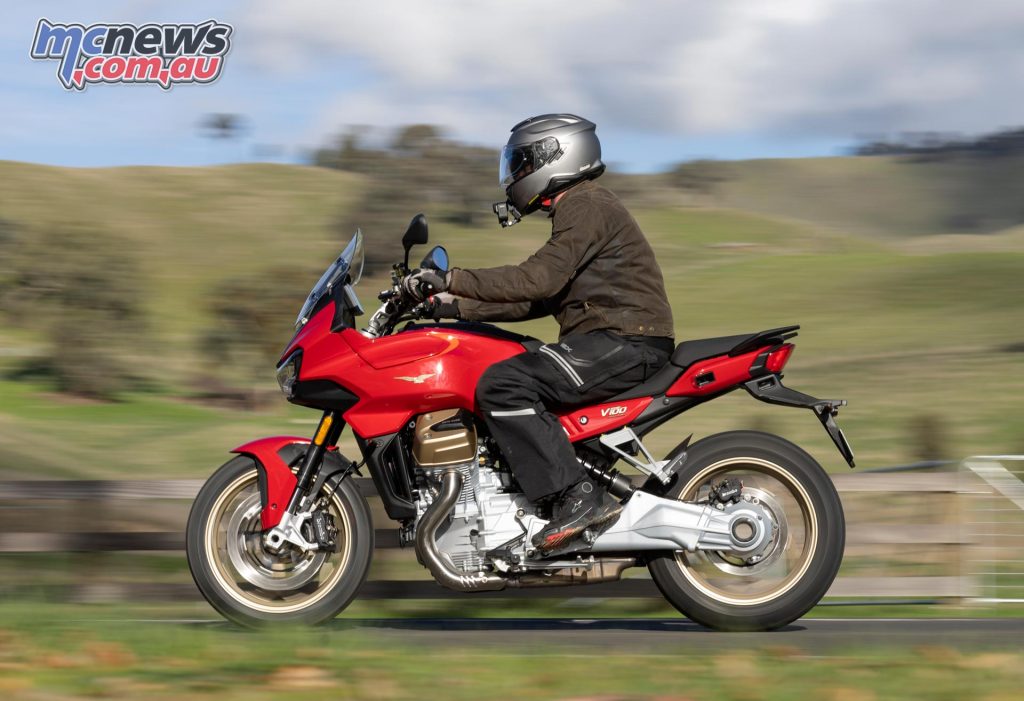
The V100 is a handsome machine with styling that ensures it stands apart. That won’t work for everyone, but then most things that everyone finds acceptable are boring, which is just not Guzzi.
Flowing bodywork accentuates the transverse V-twin, which is now liquid-cooled and has heads rotated 90-degrees compared to tradition, in a first for Moto Guzzi, and is joined by another first for the brand – a slipper clutch.
Flick that starter and the trademark Guzzi rock is still present, but not quite as pronounced as on a V7 or V9, and a twist of the throttle offers a similar reaction.
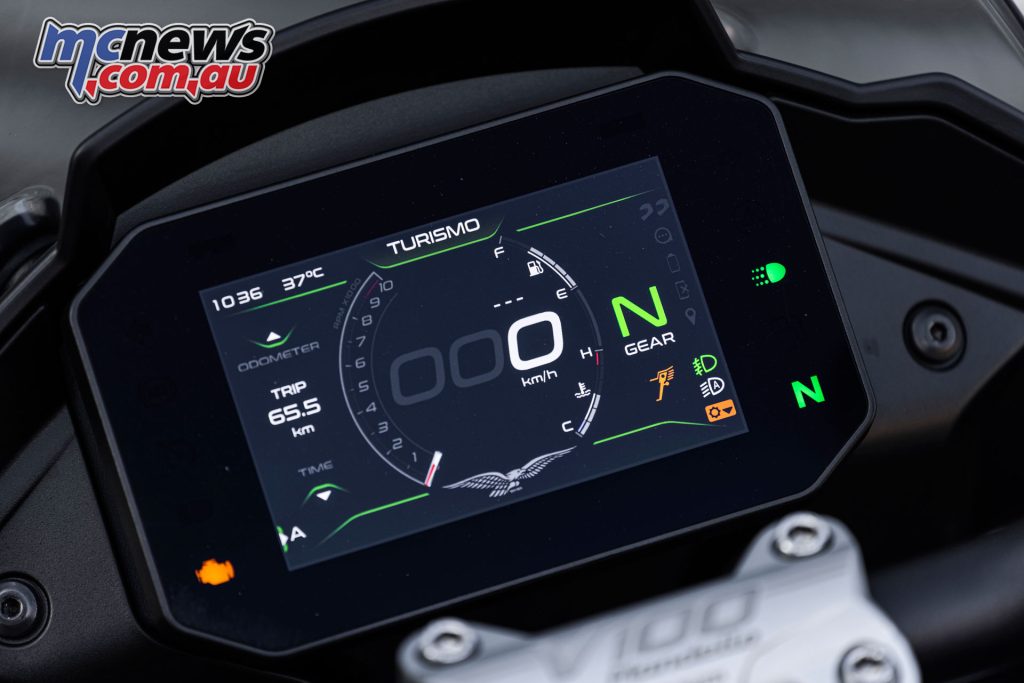
You’ve got a choice of four ride modes, a TFT dash, medium sized windscreen and a convenient 815 mm seat height to welcome you on board.
Interestingly, jumping on board the base model bike feels… not small, but really manageable for a 233 kg sports-tourer. More like a mid-capacity nakedbike than this generally bigger and taller class of machine can feel.
Choosing not to go the taller more ‘adventure’ styled tourer has paid dividends here, with the V100 carrying its centre of gravity nice and low. Add the relatively low seat height and that does make the peg to seat ratio a bit more sporty, emphasising everyday usability with a sporting bent, rather than a touring style set-up favouring all-day cross country comfort.
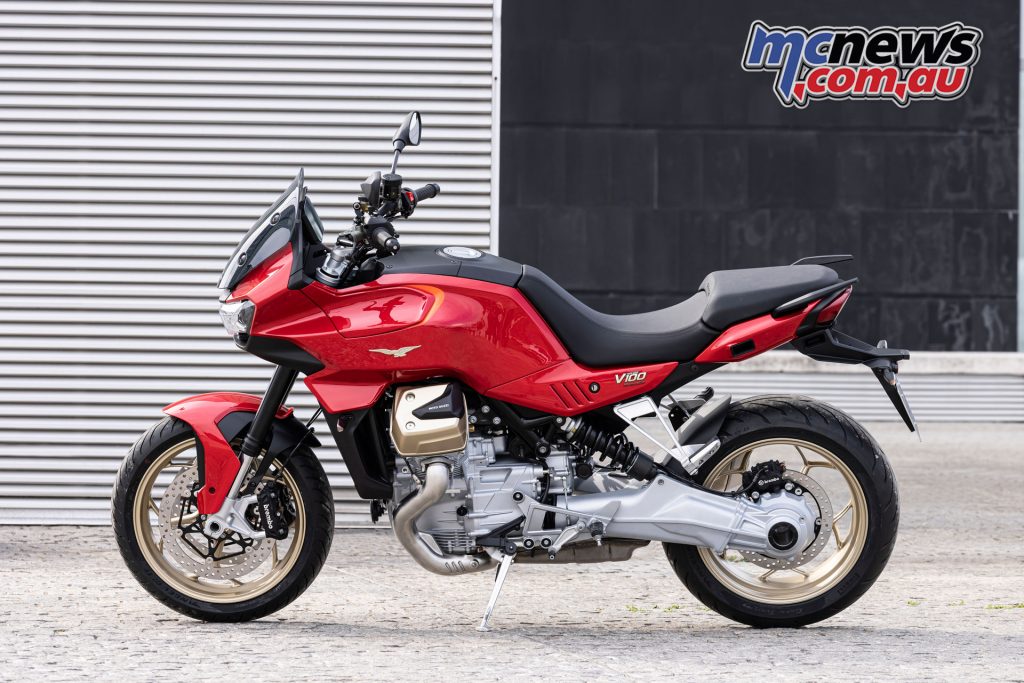
When setting out from the close confines of a Melbourne carpark a lack of available steering lock came to light, but once out onto the streets the bike revealed itself to be an easy commuting machine, when kicking off the chilly day in rain mode.
Fuelling is smooth, torque comes on low and strong. Gear-shifts are solid and clunky, but not in a bad way. Even the hydraulic clutch is nice and light.
The cold Melbourne morning does highlight the strange choice not to run standard heated grips on the base model, which retails for just over $28K here in Australia.
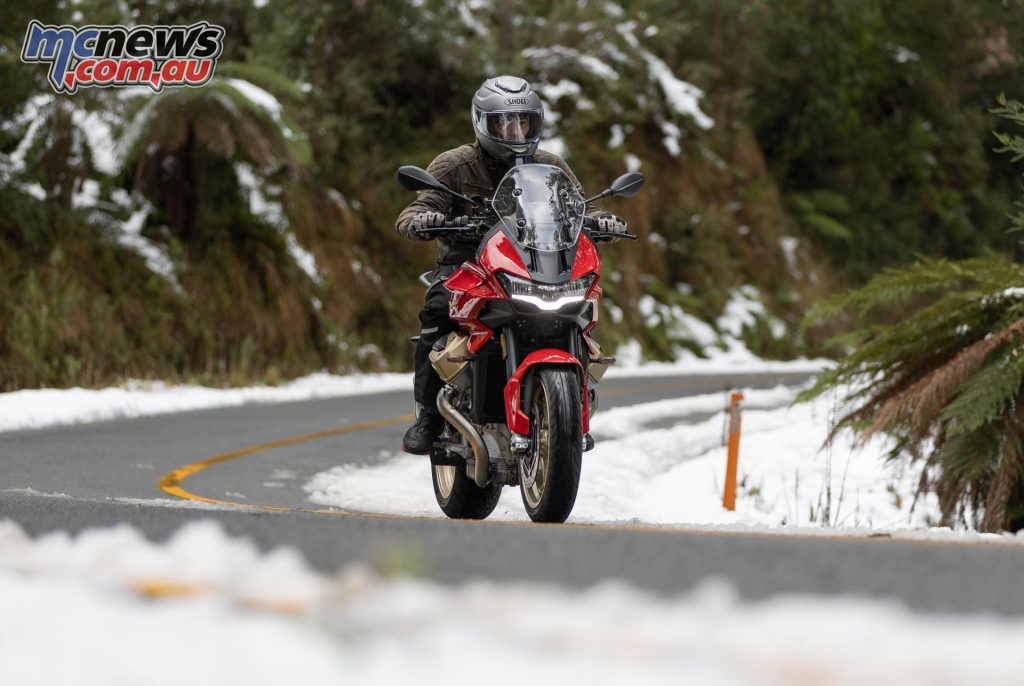
First impressions are also of a comfortable, spacious seat, wide ‘bars with good vision through the mirrors but minimal wind protection with the screen set in the lower position. In rain mode the aeros are active, but bundled up in five layers under my jacket, and with touring overpants on, it was hard to spot a big advantage from those aerodynamic aids across the two days.
Adjusting the screen up to the tallest setting though, did provide a significant improvement. The electronic adjustment can be done on the run, up to a certain speed (to protect the servo motor), depending if you’ve got the stock or larger touring screen fitted. I left that for a stop though, as unlike the modes and traction control toggles, I found myself searching through the dash to try and change the screen setting and much preferred my eyes on the road.
Heading out towards the Cathedral of Moto Guzzi in Yea and beyond is where the V100 Mandello really shines, on the open road and through the twisties.
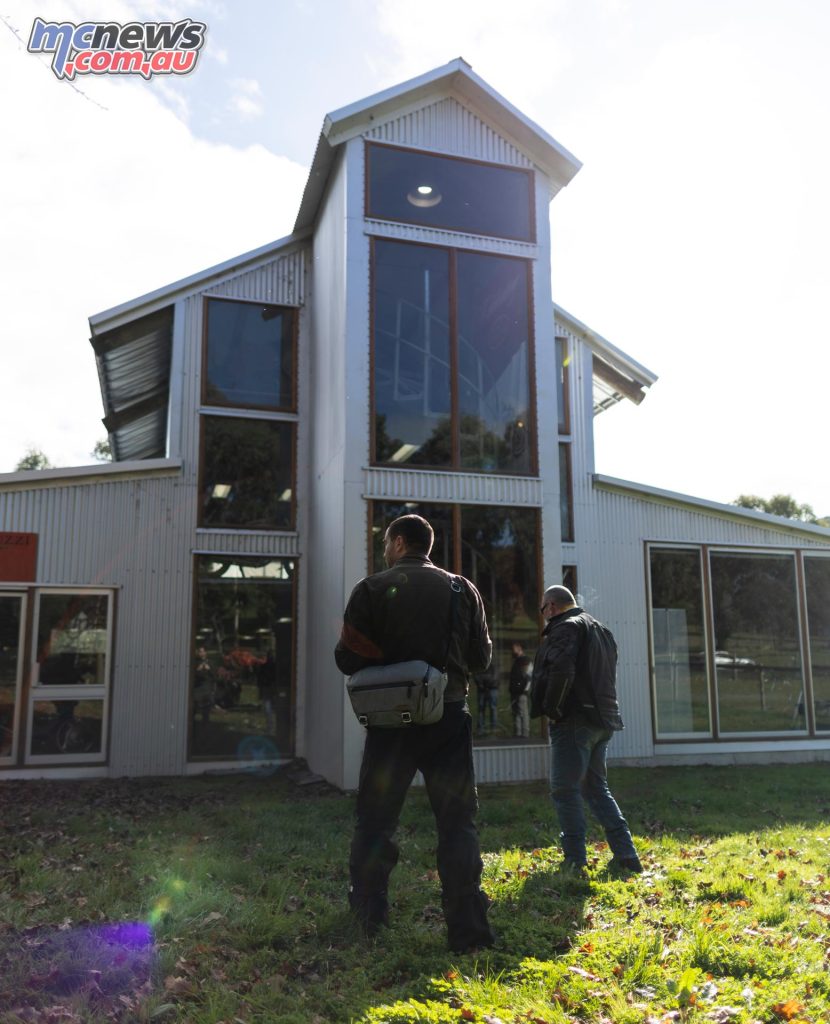
The bike has a solid, planted feel, with a strong feeling of mechanical grip, no doubt aided by the Pirelli Angel GTII tyres. Road or Touring modes seemed to be the more ideal choices for these conditions, running the mid-range power setting and less traction control intervention.
While the base model misses out on the Ohlins semi-active suspension set-up, I couldn’t but find myself impressed with the traditional suspension package. The forks are adjustable for pre-load and rebound damping. The rear shock has an external pre-load adjuster to make fettling easy, but for my size (75 kg) I found there was a pretty much ideal balance between supple, sporty and well supported across the vast majority of conditions on the standard settings.
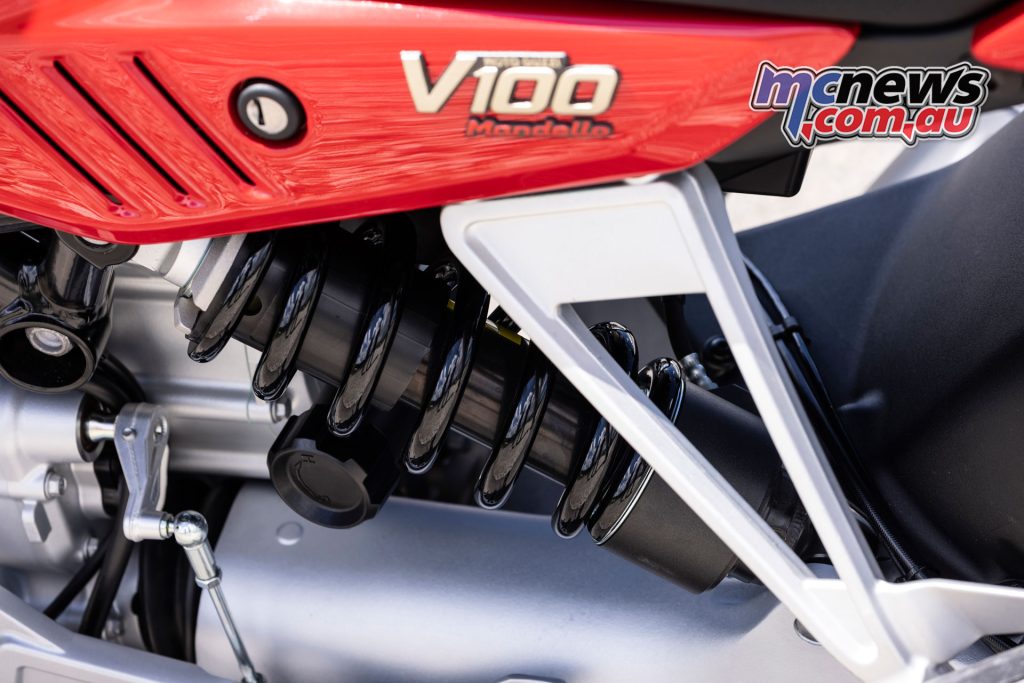
Combine that with neutral but responsive handling characteristics along with almost effortless changes of direction and you’ve got a great backroads brawler, that’ll provide plenty of confidence for a broad variety of riders.
I actually tried out Sport mode here, and ended up switching back in the tighter stuff, as while the more aggressive power delivery could add to the thrills, the relative lack of engine braking in this mode wasn’t my cup of tea.
The V100 Mandello carries its weight very well indeed, but that lower engine braking did remind me of the weight of the machine and corresponding momentum you’re carrying into corners. Conversely, in the mid-power mode that little bit of extra engine braking was much preferable to me, and that setting is baked into the power modes.
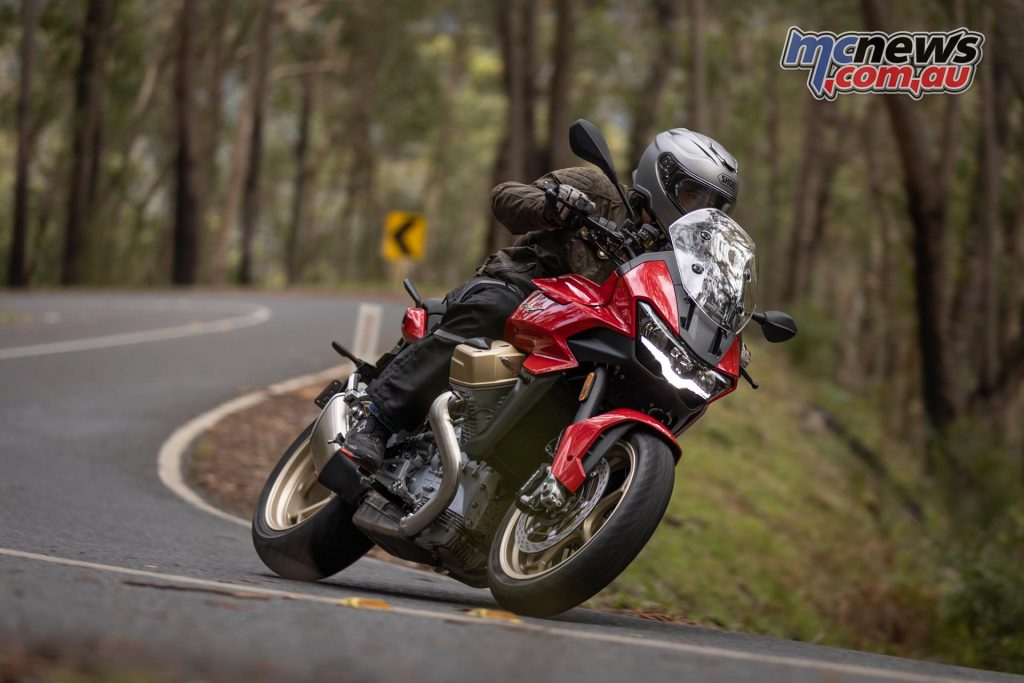
Granted I think if I owned the bike, that’s something I’d come to terms with and probably eventually enjoy, especially on roads and through corners I know well and would be more comfortable to push on.
The Brembo front brake set-up was also ideal for the conditions, I felt like there was a fair bit of lever action before you go really got into the meat of the braking effort, but there’s great power available there and good modulation past that first pull.
The rear on the bike I was riding for the first day was quite soft at the foot pedal, with a good bit of travel and limited bite, so nothing really unusual here, but also not really noteworthy.
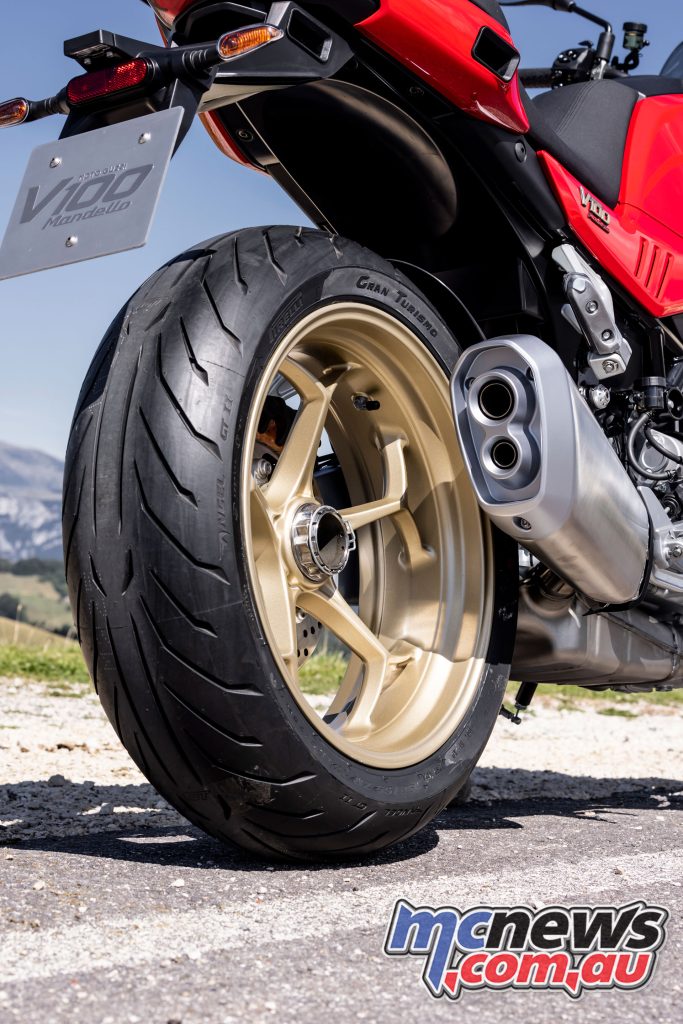
A fairly flowing approach to the twisties was definitely the most rewarding, with the V100 Mandello well balanced front to rear and flicking from side to side easily.
It’s hard to criticise the bike’s handling and suspension setup overall, which combined with exceptional torque through the vast majority of the rev range, allows for plenty of fun. Sure the V100 isn’t a supersport machine, but I’d take this over a sportsbike for the twisties any day of the week.
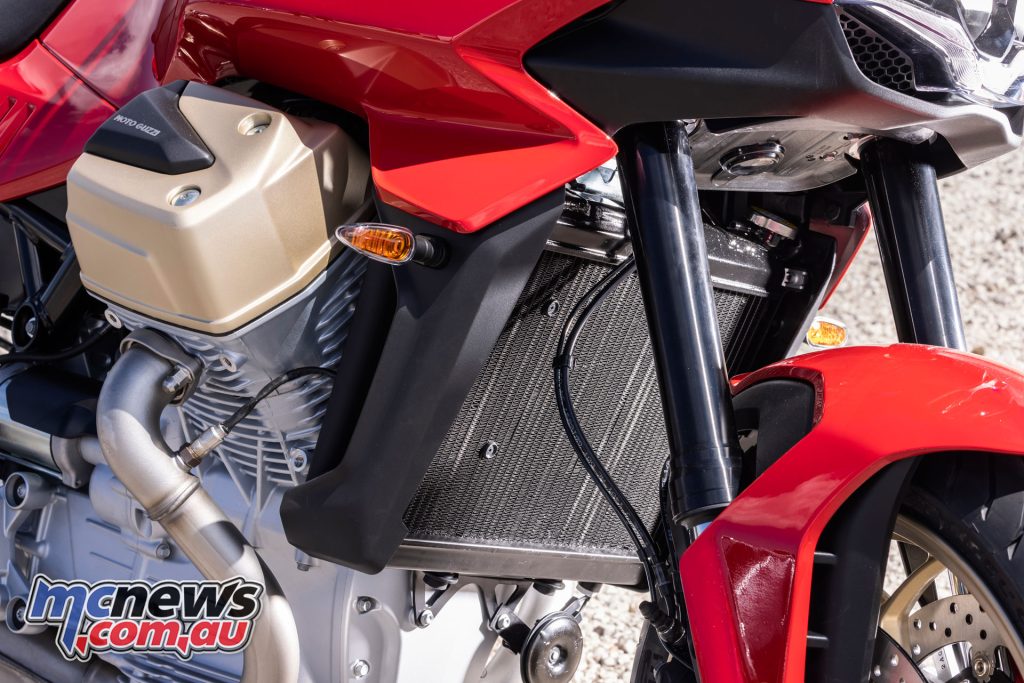
I recall cruising comfortably on the freeway with the mill turning less than 4000 rpm but still with good pick-up from there when overtaking, in fifth that’s 4500 rpm. Drop the revs even further and the bike doesn’t complain, with this Guzzi really demonstrating how good a V-twin can be, in a world increasingly delivering an endless series of parallel-twins.
Get a little higher in the revs and there’s just torque everywhere. On the one hand the mid-range is exceptional and probably all you’d need for a moderate pace rider like myself, however the top end just keeps pulling and will deliver the thrills if you’re looking to be a bit of a ratbag too.
Add a great intake roar – which at times reminded me a little of Triumph’s triples but with a meatier bass – and there’s a very nice sound track accompanying all that performance.
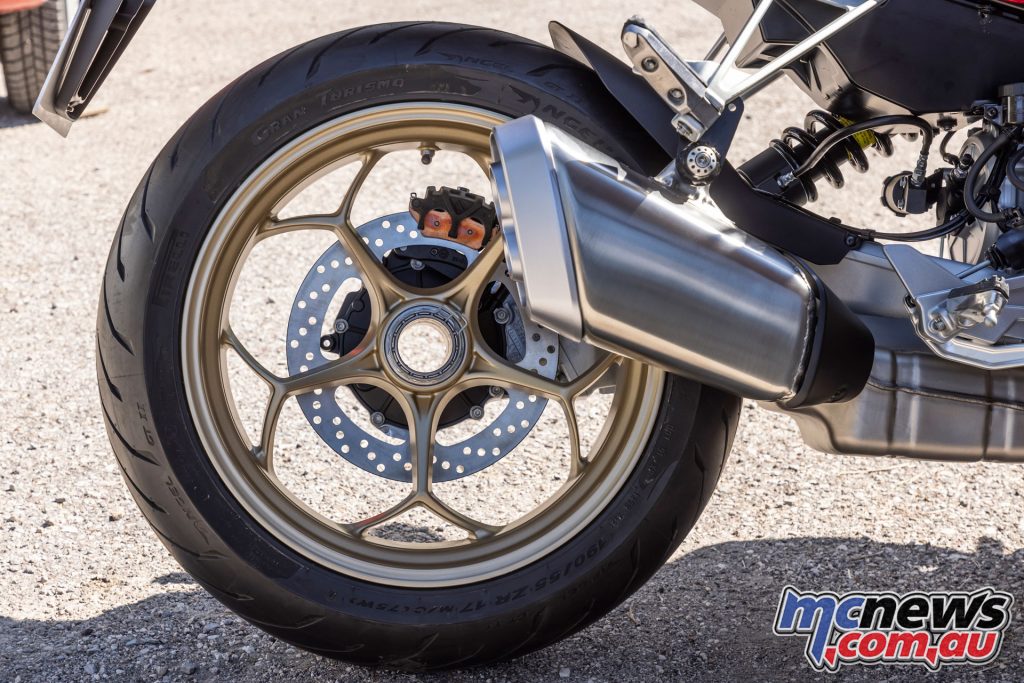
An aftermarket exhaust will take that next level, but with the restrictions seeming to get ever tighter in an attempt to make electric bikes look good, I was impressed that Moto Guzzi were able to retain that character. Starting up the bike should definitely light up your face with a smile in that regard, every time, and having a crack on the throttle likewise, here the Guzzi delivers.
V100 Mandello S
For our second day I swapped the regular V100 for the ‘S’ model which adds about $4K to the price pushing it up to just over $32K ride-away. The most notable change is the Ohlins semi-active suspension, which had me thinking this bike would be the obvious choice.
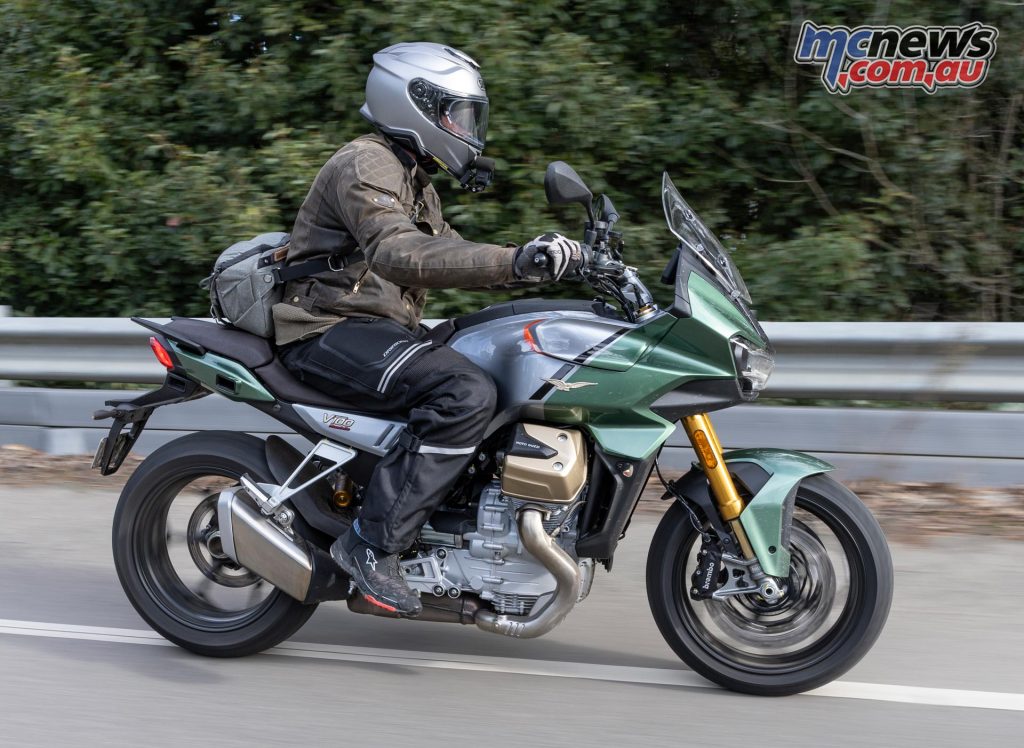
Plus you get a quick-shifter, heated grips and their Moto Guzzi MIA or multimedia and phone syncing system.
I reckon for the price, the base model should probably come with that quick-shifter and heated grips anyway, although the highest setting on those grips seemed to be about the same temperature as the lowest setting on most systems I’ve seen on other bikes. They are available in the accessory range for the regular model of course.
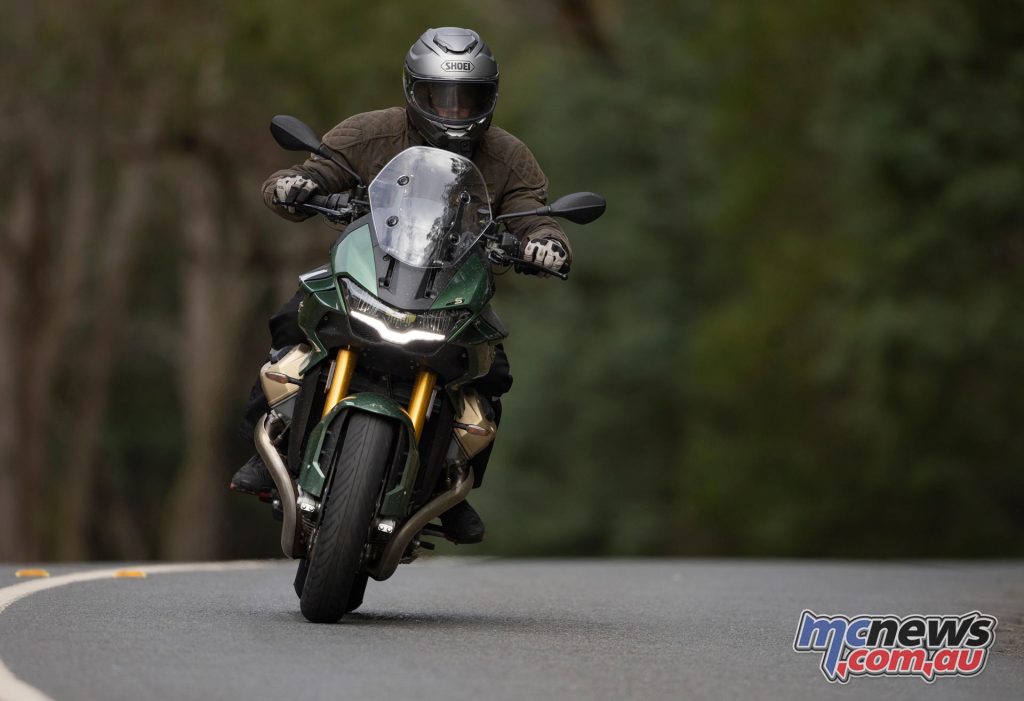
The immediate difference between the two bikes was that the Ohlins felt more comfortable for cruising, and Guzzi Australia had programmed the bikes up with a setting they thought was ideal for our Aussie conditions in the Manual presets (M-modes). Ingeniously the system then uses that as your baseline, and works actively from there, within a certain range.
There’s also full auto suspension modes (A-modes) which I ended up swapping too when we hit some rougher road conditions, just to see if that’d boost comfort – which it did – to an extent.
I would say that with most of these electronic suspension systems, you need to spend more time with the bike to really click with the differences to a traditional set-up, which was the case for me here too.
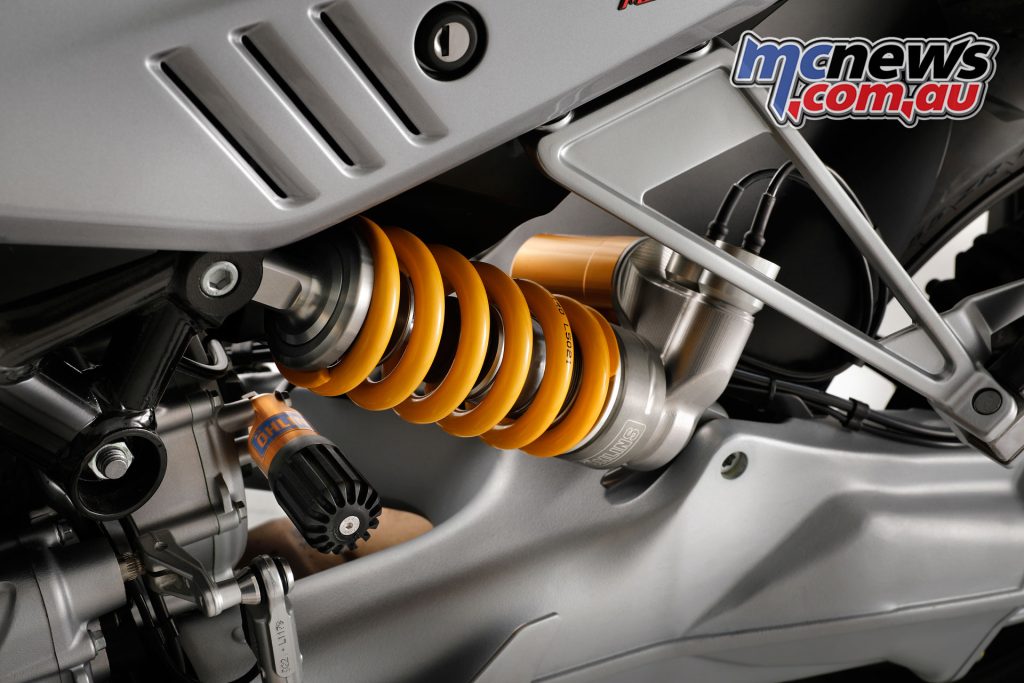
Generally I’m a huge fan of the electronic suspension set-ups, because of their ease of use, and ability to get a really good ride out of them, even as someone who doesn’t have a degree in the black magic of suspension adjustment.
However, the base V100 was so good that I didn’t feel there was as significant a difference as I expected. I have a feeling with long term ownership the extra adjustability of the Ohlins will pull further ahead, as you come to terms with the different feel and add a pillion from time to time, but I’d be happy with the base bike.
The quick-shifter was a big boon though, while I liked the gearbox on the V100, I did find myself missing shifts, and occasionally having to take another bite at the apple if I was downshifting a few gears at a time. Some things change, some things stay the same… As ever, this Guzzi wants a very deliberate use of both the clutch and shifter on a bike without the quick-shifter.
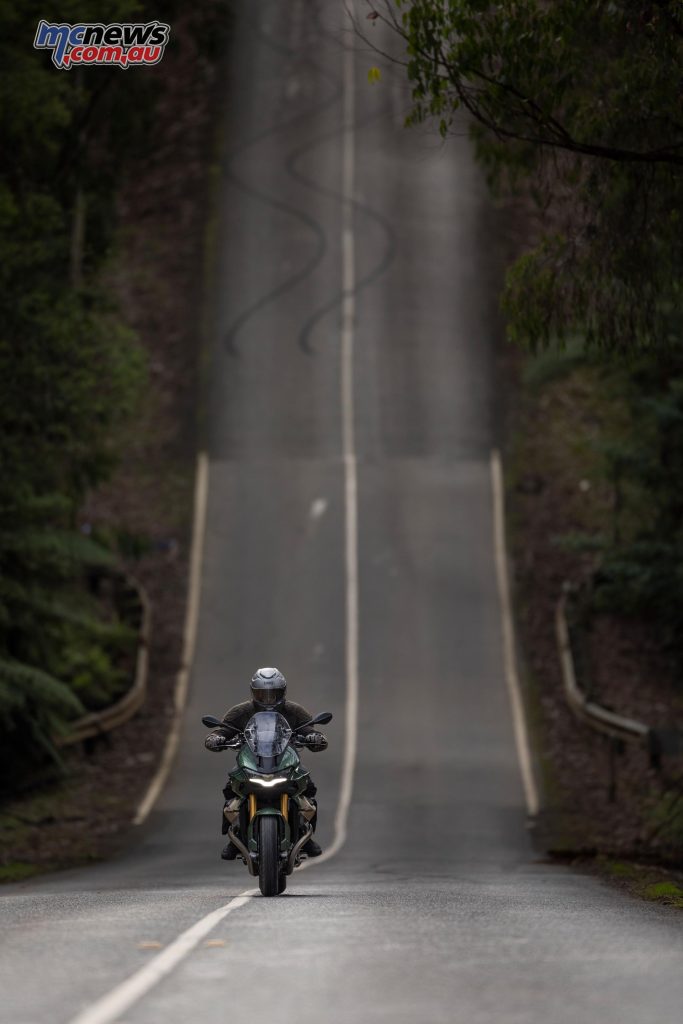
The quick-shifter solved that by not requiring the clutch at all with upshifts working very well, and downshifts likewise doing an ideal job, if occasionally being a little resistant, which I think came down to unfamiliarity with getting the best out of the system in regards to throttle position.
The dash user interface is obviously designed from the outset for the V100 Mandello S, which has the extra Ohlins settings and multimedia system built in.
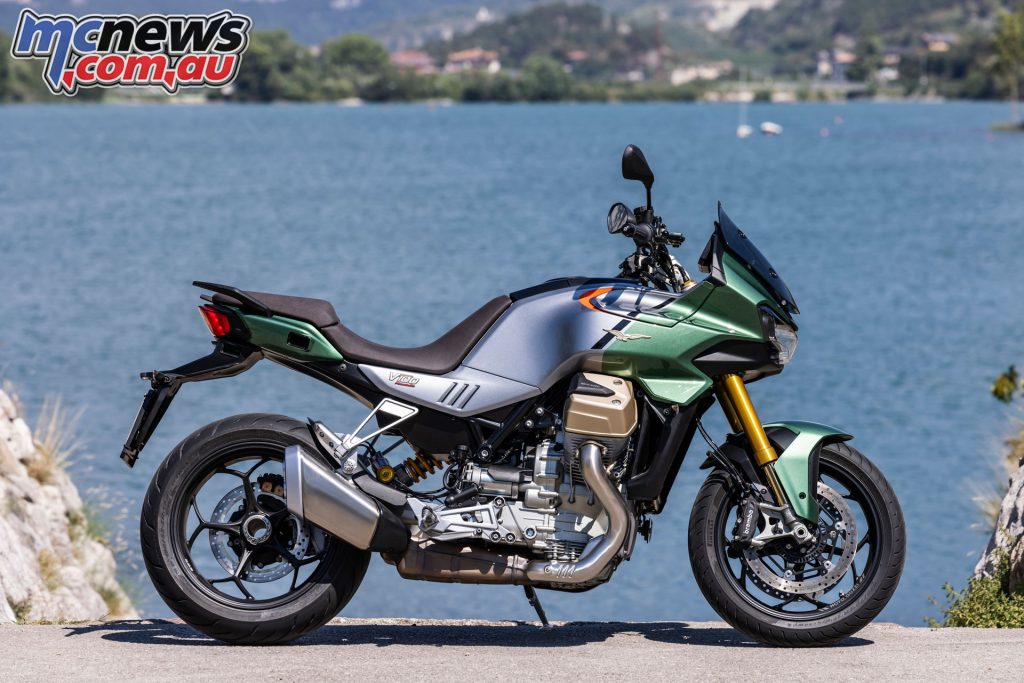
I found it much easier to flick through the settings on the S model, and to find those settings and the heated grips, than I did on the base model, where some sections were just empty due to those missing features. It just felt more intuitive.
V100 Mandello Final Thoughts
Moto Guzzi have done an exceptional job with the V100 Mandello. They reckon it sits between a tourer and nakedbike, which is sports-touring territory and I can’t argue with that. The bike feels like it can cover both bases well, without the compromises some sports-tourers make, in regards to feeling taller, larger and more top heavy.
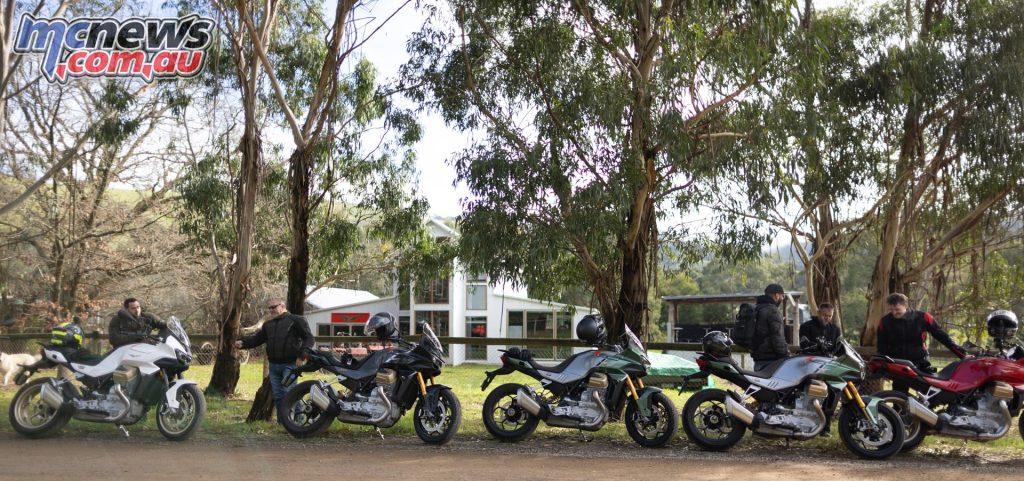
The engine is an exceptional powerplant too and should certainly stand up to the competition. Maybe not as the fastest, but it’s a bloody good thing and retains plenty of that true Guzzi character.
Handling likewise is impressive, this is a planted, responsive and fun machine to ride. The Brembo brakes did a good job, as always.
While I didn’t notice a big difference with the aeros, I ended up just setting all of the modes to have them active – Victoria is a bit chilly after all, we even saw some snow!
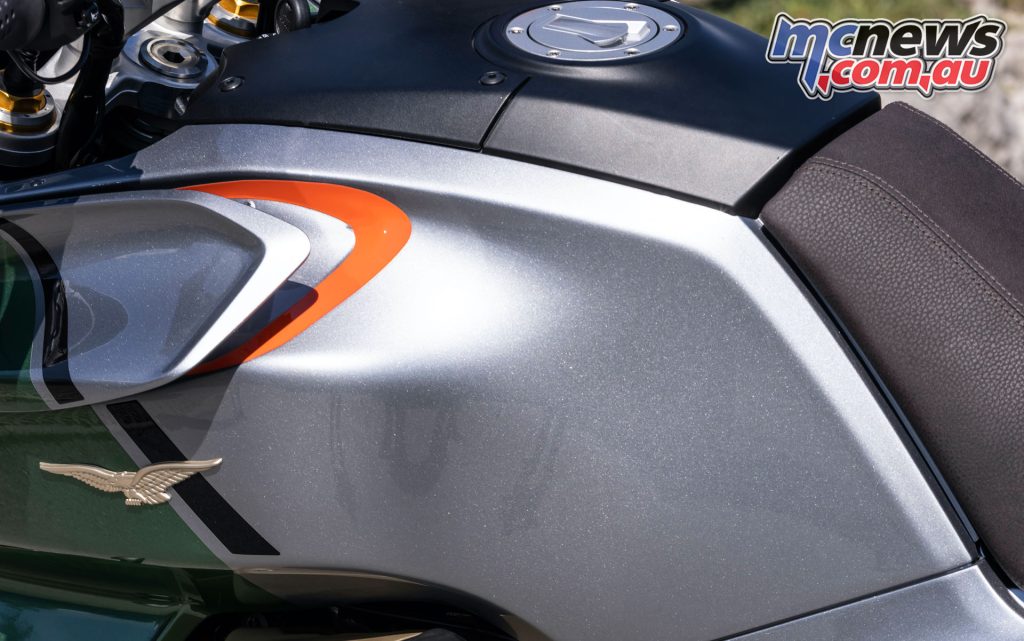
You can have the aero aids on or off all the time, or set them to activate at a specific speed, and they are linked to your ride modes.
Put the screen at the lowest setting and turn the aero off, and the V100 Mandello is easy to treat as a nakedbike, instead of a sports tourer.
I’d probably opt for the taller and larger accessory screen, at least for winter use, and explore the pannier option for the longer trips. The tail runs integrated luggage mounting points, which is very clean. Then I’ve got a great two-up tourer, and an ideal everyday machine or weekend blaster all in one.

The electronics suite covers modern expectations and the ABS and TC do use an IMU. This is perhaps not the most intuitive set-up, however as an owner you’ll work out how everything works and that shouldn’t be an issue.
Overall basic use was easy, you’ve got a mode button near the starter and can switch modes on the fly, just close the throttle to activate the selected mode if you’re moving. The cruise control toggle also doubles for changing the traction control on the fly, when the cruise control isn’t active.
For delving deeper into the dash and electronics you probably want to be at a standstill.
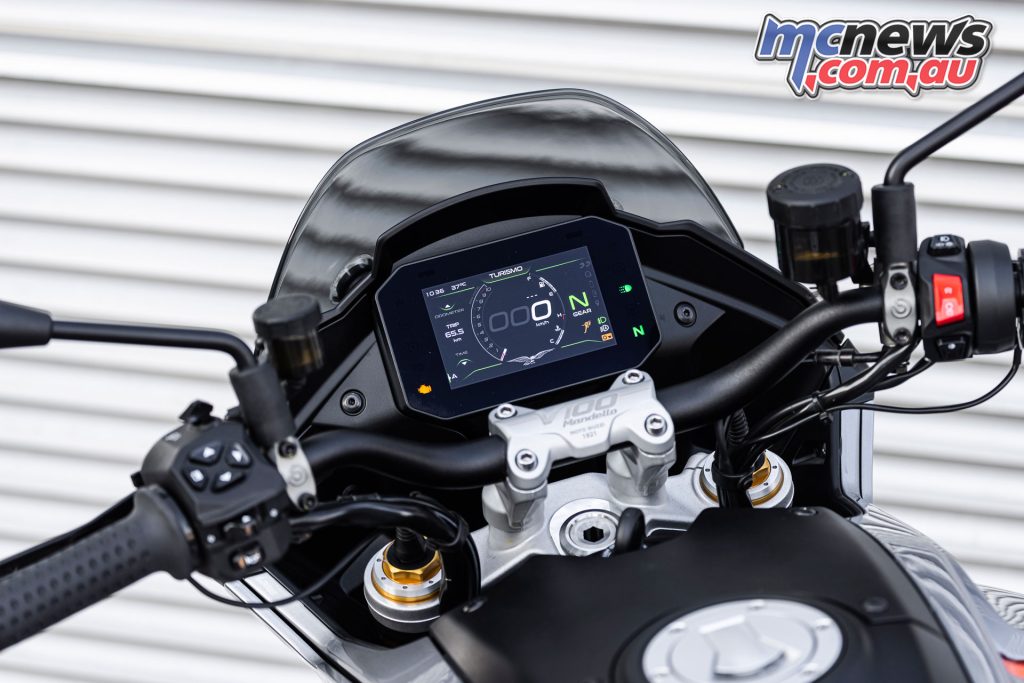
A set of shiny Ohlins suspension, the multimedia system and quickshifter certainly justify the upgrade to the V100 Mandello S, but it’s less of an obvious choice that I thought it would be.
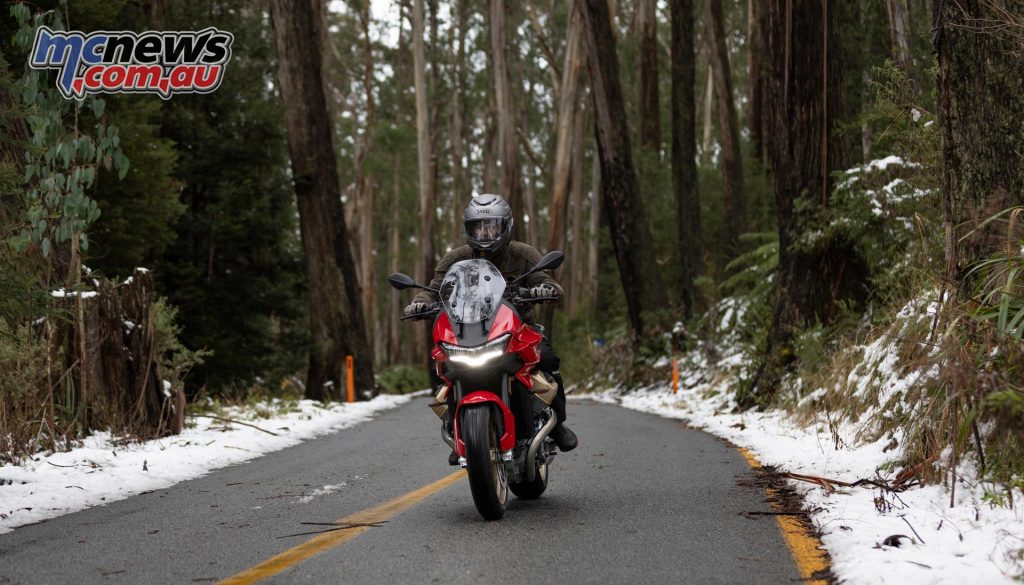
It’s a fairly hefty price of admission, but that’s increasingly the norm for this segment, and the bike is well decked out to justify that price.
There is also that draw of Moto Guzzi uniqueness, encompassing the styling, engine sound and character.
If the bike sparks your interest line yourself up a test ride to see if it floats your boat. I don’t think you will be disappointed.
2023 Moto Guzzi V100 Mandello Video Review
2023 Moto Guzzi V100 Mandello [S] Specifications
| 2023 Moto Guzzi V100 Mandello [S] Specifications | |
| Type | Liquid-cooled 90° transverse V-twin. Double overhead camshaft timing with finger followers and four valves per cylinder |
| Capacity | 1042 cc |
| Bore x stroke | 96 x 72 mm |
| Compression ratio | 12.6 : 1 |
| Max Power | 115 hp (84.6 kW) at 8700 rpm |
| Max Torque | 105 Nm (10.7 kgm) at 6750 rpm |
| Fuel system | Electronic injection; 52 mm double throttle body, Ride-by-Wire |
| Fuel capacity | 17 litres (including 3.5 litre reserve) |
| Emissions compliance | Euro 5 |
| Consumption (WMTC cycle) | 4.7 l/100 km |
| CO2 Emissions (WMTC cycle) | 118 g/km |
| A/C generator | 550 W |
| System voltage | 12 V |
| Battery | 12V – 12 Ah |
| Clutch | Hydraulic multi-plate wet clutch with anti-juddering system |
| Transmission | Six speed [Six speed with electronic quick shift system] |
| Primary drive | Straight cut gears and integrated flexible coupling, gear ratio: 31/48 (1.548) |
| Secondary drive | Cardan shaft: Drive ratio: 12/38 (3.166) |
| Electronics | Three engine mappings (MGCM), Two level engine brake control (MGFM), four level traction control (MGTC), cruise control. Four Riding Modes (Tour, Rain, Road, Sport) [Quick shift] |
| Chassis | High strength steel tubular frame |
| Front suspension | Hydraulic telescopic 41 mm USD fork, adjustable in spring preload and rebound [Öhlins Smart EC 2.0 semi-active fork, 43 mm USD with superficial TIN treatment, fully adjustable] |
| Front travel | 130 mm |
| Rear suspension | Aluminium single-sided swingarm with left-hand single shock, adjustable in spring preload, via a knob, and in rebound [Öhlins Smart EC 2.0 semi-active single shock that is fully adjustable and complete with spring preload adjustment via a knob] |
| Rear travel | 130 mm |
| Brakes Front | 320 mm double floating disc in stainless steel, Brembo radial callipers with four opposed pistons and a metal trellis tube, Continental ABS with cornering function |
| Brakes Rear | 280 mm stainless steel disc, Brembo two-piston floating calliper, Continental ABS with cornering function |
| Wheels | Aluminium alloy |
| Wheels | 3.50 x 17in, 6.00 x 17in |
| Tyre | Radial tubeless, 120/70 – R17, 190/55 – R17 |
| Length | 2125 mm |
| Width | 835 mm |
| Wheelbase | 1475 mm |
| Seat height | 815 mm (accessories: low seat 800 mm; high seat 835 mm) |
| Headstock angle | 24.7° |
| Trail | 104 mm |
| Dry weight | 212 kg |
| Kerb weight* | 233 Kg |







